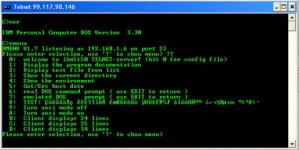Is it really that complicated? The manual is supposed to tell you all the necessary details and there also is an example configuration file.
If all that doesn't help you, just ask.

I guess its complicated to me when I'm trying to do this stuff at around midnight whith limited brain function left.

On the topic of the RMENU.MEN configuration file:
MORE rmenu.men Display the configuration file <--------------this works!
MORE rmenu.doc Display the program documentation <-------this works too! ( I guess you could make it display any .doc file? like a telnet "library"!)
MOREL * "*.txt" "*" Display text file from list <--------------I forget what this one does ...
SYSM dir Show the current directory <----------this shows a dir of where you place rmenu.exe, can you change dir's, i.e., "cd"?
SYSV set Show the environment <----------------also forget what this does ...
SYSI date ^m Get/Set host date <-----this is to be avoided! it makes the server hang, (until I manually enter the time/date ON the actual machine itself).
SYSI c:\command ^Cexit^M real DOS command prompt ( use EXIT to return ) <----this idea of this is AMAZING, however it crashes a lot and I can't get it to work.
SHELL "[RMENU] " emulated DOS prompt ( use EXIT to return ) <--------what's the difference between real/emulated mode?
SETL 0 TEST: €�‚ƒ„…†‡ ˆ‰Š‹Œ�Ž� �‘’“”•–— ˜™š›œ�žŸ *¡¢£¤¥¦§ ¨©ª«¬*®¯ øñýáöù <---------huh? what's this for?
ansi 0 Turn ansi mode off
ANSI 1 Turn ansi mode on
SETL 24 Client displays 24 lines
SETL 25 Client displays 25 lines
SETL 34 Client displays 34 lines
It would be great if the manual had more examples of how to operate/configure RMENU for some common use cases, i.e.:
--running a program
--downloading files
--uploading files
--re-booting into RMENU if there's a crash

